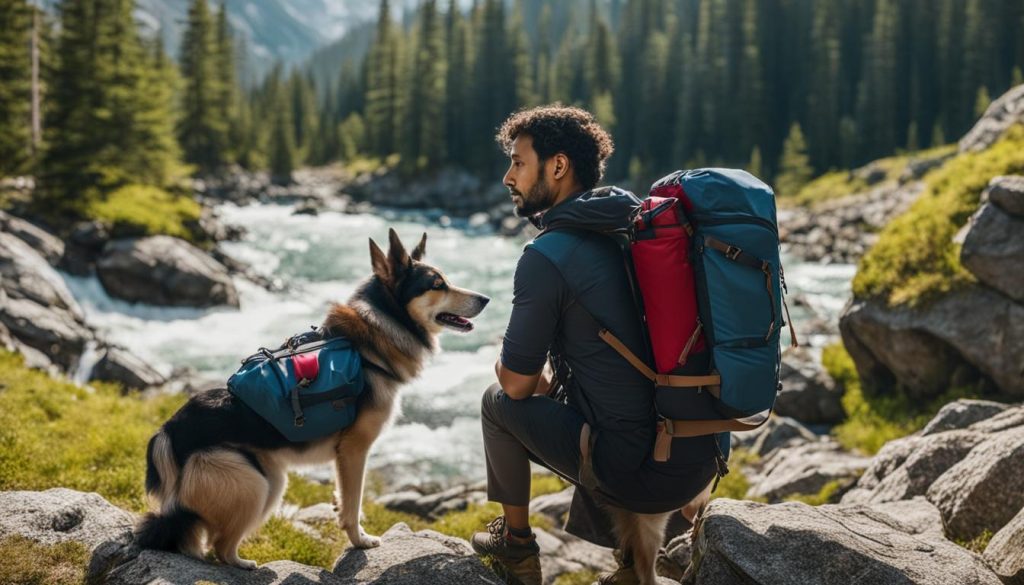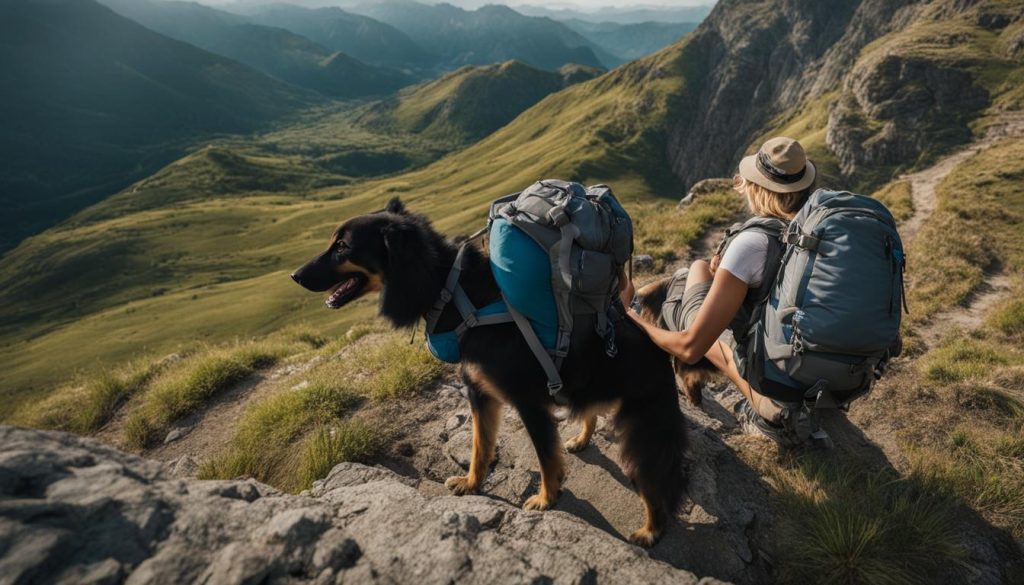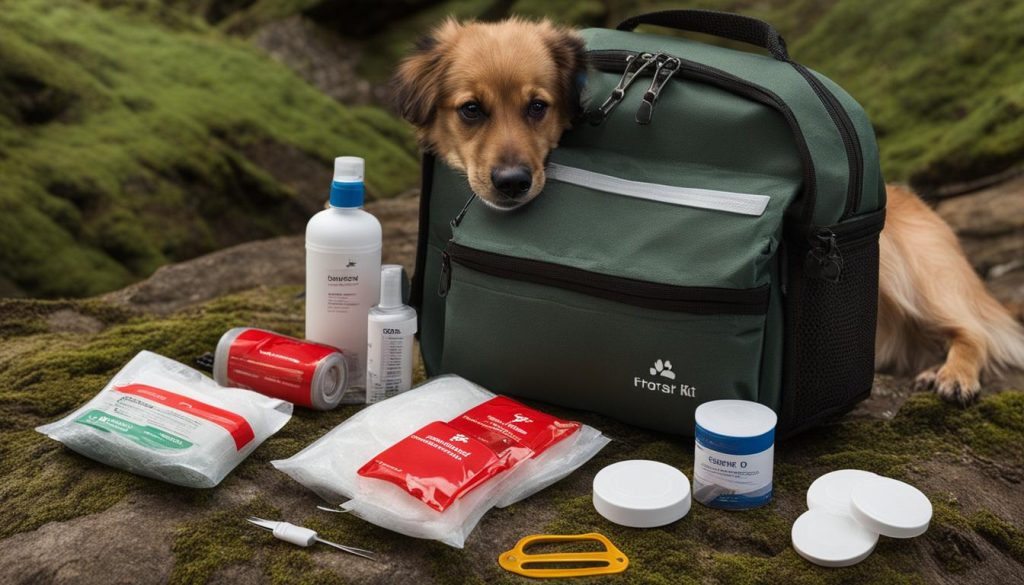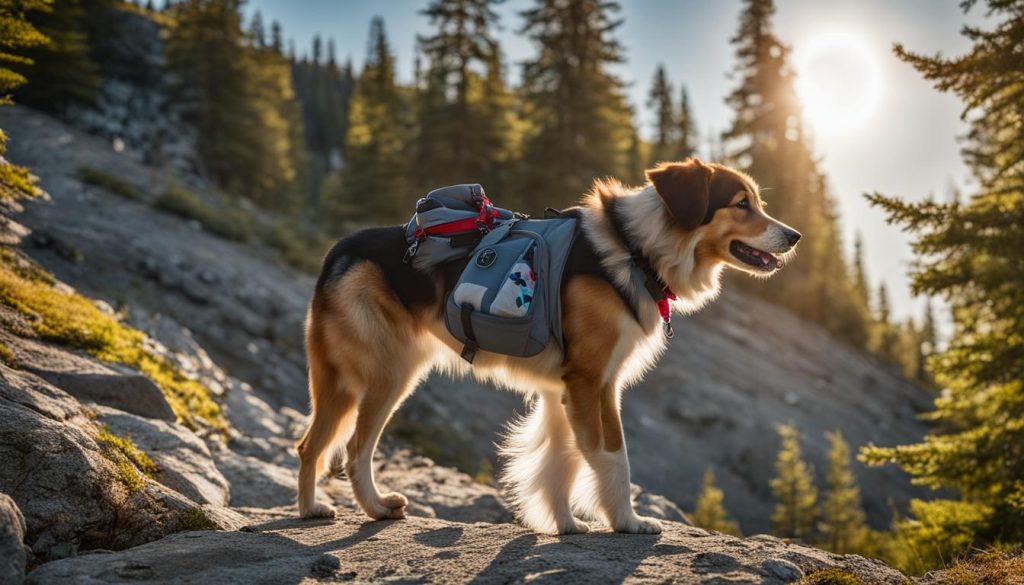As a devoted dog owner and outdoor enthusiast, I understand the importance of ensuring the safety and well-being of our furry companions during hiking adventures. Unfortunately, accidents can happen, and our beloved dogs may sustain injuries while exploring the trails with us. In such situations, it is good practice to know how to properly carry an injured hiking dog to provide them with immediate care and support.
Key Takeaways:
- Knowing the proper technique for carrying an injured dog on the trails is essential for their well-being.
- The ‘over the shoulders method’ is recommended for carrying an injured dog, utilizing your body’s core strength.
- Consider practicing carrying your dog using the ‘over the shoulders method’ before an emergency situation arises.
- The ‘over one shoulder method’ is an alternative option for restless dogs, allowing them to face forward.
- For smaller dogs, pet carrier backpacks provide a convenient and secure way to carry them on hiking trips.
The ‘Over the Shoulders Method’
The ‘over the shoulders method’ is the recommended technique for carrying an injured dog on the trails. You might want to use the proper technique when supporting and transporting injured dogs to ensure their safety and well-being. This method, also known as the ‘fireman’s lift,’ is widely used by the military and police dog squads due to its effectiveness.

To use the ‘over the shoulders method,’ it is essential to start by practicing in the water. This helps your dog become accustomed to being on your shoulders and increases their comfort level. Begin in deeper water, allowing your dog to lie across the back of your neck and shoulders with their legs in front of you. Gradually move into shallower water and then try the method out of the water.
When performing the ‘over the shoulders method,’ make sure to engage your core muscles and legs for the lift. This will help distribute the weight evenly and minimize strain on your back. Additionally, ensure a safe landing by bending your knees when setting your dog down. You might want to consider your fitness level, the size of your dog, and the nature of the injury to determine if this method is suitable.
Benefits of the ‘Over the Shoulders Method’
- Utilizes core strength: The ‘over the shoulders method’ relies on your body’s core strength, making it a suitable technique for carrying an injured dog on the trails.
- Comfort and stability: This method provides stability for the dog as they can rest comfortably on your shoulders, allowing you to navigate the trails more easily.
- Visibility: Carrying your dog in this manner allows them to see their surroundings and face forward, which can help alleviate stress and anxiety.
Overall, the ‘over the shoulders method’ is a proper technique for carrying an injured dog while hiking. By practicing this method and considering the specific needs of your dog, you can provide the necessary support and transport them safely on the trail.
The ‘Over One Shoulder Method’
When it comes to carrying an injured dog while hiking, the ‘over one shoulder method’ is an alternative technique that can be used. This method is particularly useful for restless dogs as it allows them to see where they are going and face forward. However, it does require the dog to support themselves and balance more on your shoulders, so you should ensure that your dog is alert and balanced during this method.
To execute the ‘over one shoulder method’, start by bending down and placing one arm under the dog’s chest, with your hand supporting their front legs. Then, use your other arm to support their rear legs and tail. Lift the dog onto your shoulder, making sure to hold them securely. Ensure that their weight is evenly distributed to maintain balance and stability.
This method is best suited for dogs that are small to medium in size and have relatively minor injuries. It may not be suitable for larger dogs or those with more severe injuries, as it puts more strain on your shoulders and may not provide adequate support for the dog’s weight. In such cases, it is advisable to use the ‘over the shoulders method’ or consider alternative methods of transport, such as a makeshift stretcher or sledge.

Tips for Carrying an Injured Dog in the Wilderness:
- Ensure your dog is comfortable with the method before attempting it in a real-life situation.
- Use caution and proper lifting techniques to prevent personal injury.
- Communicate with your dog, providing reassurance and support throughout the process.
- Consider using additional support, such as a sling or harness, if necessary.
- Seek immediate veterinary attention for your dog once safely off the trail.
By following these tips and using appropriate carrying methods, you can ensure the safety and well-being of your injured hiking dog while out in the wilderness.
The Front Method or The Two Hand Hold
When it comes to carrying an injured dog on the trails or over long distances, the front method, also known as the two hand hold, can be an effective technique. This method involves picking up the dog from the front by holding one arm in front of their chest and the other arm behind their legs and tail. It allows for better control and stability while carrying the dog.
However, you should note that the front method is not suitable for carrying large dogs over long distances as it can put strain on your lower core and back muscles. It is best used for placing the dog on surfaces such as the boot of a car or the vet’s table. For extended periods of carrying or hikes with challenging terrain, it is recommended to use the ‘over the shoulders method’ or consider using essential gear such as a dog carrier backpack.
Essential Gear for Carrying an Injured Dog on a Hiking Trip
When carrying an injured dog on a hiking trip, having the right gear is essential. Here are a few items that can make the process easier and more comfortable for both you and your furry companion:
- A dog carrier backpack: This allows you to carry small dogs on your back, distributing their weight evenly and leaving your hands free.
- A leash or harness: Attach a leash or harness to the dog’s collar or body to ensure they stay secure and prevent further injuries while being carried.
- A dog first aid kit: Include items such as gauze rolls, nonstick bandages, adhesive tape, latex gloves, tweezers, sterile saline, a spare leash, and a muzzle to provide immediate care in case of an injury.
- Extra clothing or blankets: Use these to provide padding and support for the injured dog while being carried.
By being prepared with the right gear, you can ensure the safety and comfort of your injured dog while hiking.
| Essential Gear for Carrying an Injured Dog on a Hiking Trip |
|---|
| Dog carrier backpack |
| Leash or harness |
| Dog first aid kit |
| Extra clothing or blankets |
To put it simply, when carrying an injured dog on the trails, prioritize their comfort and safety. Take breaks as needed and monitor their condition closely. If the dog’s condition worsens or you’re unsure about the severity of the injury, it’s best to seek veterinary attention as soon as possible.

How to Carry an Extra-Large Dog on the Trails
When it comes to carrying an extra-large dog on the trails, there are a few considerations to keep in mind. These dogs require special attention and careful planning to ensure their safety and comfort while hiking. Here are some tips for carrying an injured extra-large dog during your hike:
- Choose easily accessible hikes: Opt for trails that are not too strenuous and have a gentle incline. This will make it easier to navigate with an injured dog.
- Hike with a group: If possible, hike with a group of people. This way, one person can stay with the injured dog while others seek further help or assistance.
- Carry an emergency dog carrier pack: Consider carrying a specialized backpack carrier designed for injured dogs. These packs provide support and comfort while allowing you to continue hiking.
- Inform someone of your hiking plans: Before embarking on your hike, make sure to inform a trusted friend or family member of your hiking plans, including the trail you’ll be on and your estimated return time. This way, someone is aware of your whereabouts in case of an emergency.
- Create a makeshift stretcher or sledge: In the event of a serious injury, you may need to transport your dog across smooth ground. As a precaution, familiarize yourself with techniques for creating a makeshift stretcher or sledge using materials available in nature.
By following these guidelines, you can ensure that both you and your extra-large dog have a safe and enjoyable hiking experience, even in the unfortunate event of an injury.

Table: Carrying an Injured Extra-Large Dog on the Trails
| Considerations | Tips |
|---|---|
| Choose easily accessible hikes | Opt for trails that are not too strenuous and have a gentle incline. |
| Hike with a group | Ensure there are people who can stay with the injured dog while others seek help. |
| Carry an emergency dog carrier pack | Invest in a specialized backpack carrier designed for injured dogs. |
| Inform someone of your hiking plans | Let a trusted friend or family member know your hiking plans and estimated return time. |
| Create a makeshift stretcher or sledge | Be prepared to transport your dog across smooth ground if necessary. |
To put it simply, always prioritize the safety and well-being of your dog while hiking. With proper planning and the right equipment, you can provide the necessary support and comfort to ensure a smooth hiking experience for both you and your extra-large dog.
Pet Carrier Backpacks
When it comes to carrying small dogs on hiking trips, pet carrier backpacks are an excellent option. These backpacks provide a convenient and comfortable way to transport your furry friend while keeping your hands free. Look for a backpack that sits securely on your back, distributing the weight evenly and allowing for better balance on the trails.
Using a pet carrier backpack offers several advantages. It allows you to keep moving even when your dog gets tired, making it easier to cover more ground on your hiking adventure. Additionally, it provides a secure and cozy space for your dog, ensuring their safety and comfort during the journey.

When selecting a pet carrier backpack, consider the size and weight capacity to match your dog’s needs. Opt for a backpack that has adjustable straps and a padded back panel for added comfort and support. Some backpacks also come with mesh windows and ventilation to keep your dog cool and allow them to observe their surroundings.
Before heading out on the trails, I would advise that you familiarize your dog with the backpack. Start by placing them in the carrier at home and gradually introduce short walks to help them acclimate to the experience. This will ensure that your hiking trips with your small dog are enjoyable for both of you.
Dog First Aid Basics
When hiking with your dog, please be prepared for any potential injuries that may occur on the trail. Dog first aid is an essential skill that can help reduce pain and prevent further injury until professional medical care can be provided. Here are some basic dog first aid techniques and supplies to have on hand while hiking:

- Wound care: Clean any cuts or scrapes with sterile saline and use nonstick bandages to cover the affected area. Use adhesive tape to secure the bandages in place.
- Stabilization: If your dog has a possible fracture or sprain, immobilize the affected limb by creating splints using materials like sticks, towels, or clothing. This can help prevent further injury during transport.
- Muzzle: In case your dog is in pain or frightened, have a muzzle to safely handle them without the risk of being bitten. A simple gauze muzzle or a commercially available muzzle can be used.
- Contact information: Keep a list of emergency contact numbers, including your regular veterinarian and the closest veterinary clinic or hospital. This will ensure you have the necessary information in case of an emergency.
“Dog first aid aims to reduce pain and prevent further injury until additional medical care can be provided.”
To put it simply, seek professional veterinary care as soon as possible after an injury occurs. Dog first aid is meant to provide temporary relief and support, but it does not replace proper medical attention. By being prepared with the necessary supplies and knowledge, you can help ensure the safety and well-being of your hiking dog.
Common Injuries While Hiking with Dogs
When hiking with our furry friends, it’s important to be aware of the potential injuries they may encounter on the trails. Understanding these common injuries can help us take the necessary precautions to prevent them and be prepared to manage them if they do occur.
One of the most frequent injuries hiking dogs may experience are insect bites. Insects such as ticks or fleas can transmit diseases to our canine companions, so using insect repellent specifically formulated for dogs is vital. Additionally, strains, sprains, and broken bones can occur when dogs jump or land improperly, especially on uneven terrain. Keeping our dogs on a leash and controlling their movements can significantly reduce the risk of these injuries.
Cuts and scrapes are another common injury while hiking. Dogs may brush against sharp objects or encounter rough surfaces that cause abrasions. Carrying a dog first aid kit with items such as gauze rolls and adhesive tape can help us provide immediate care until veterinary attention is available. It’s also essential to have proper hiking gear for our dogs, such as boots to protect their paws from sharp objects and rough surfaces.
“Understanding these common injuries can help us take the necessary precautions to prevent them and be prepared to manage them if they do occur.”
Table:
| Injury | Prevention | Treatment |
|---|---|---|
| Insect Bites | Use dog-specific insect repellent | Monitor for signs of infection and seek veterinary care if necessary |
| Strains, Sprains, and Broken Bones | Keep dogs on a leash and control their movements | Seek veterinary care immediately and restrict physical activity |
| Cuts and Scrapes | Carry a dog first aid kit and use proper hiking gear | Clean the wound, apply appropriate dressings, and seek veterinary care if necessary |
By staying vigilant and taking preventive measures such as using insect repellent, keeping dogs on a leash, and providing them with the necessary gear, we can minimize the risk of common injuries while hiking with our four-legged companions. Being prepared with a dog first aid kit and knowing how to administer basic wound care is crucial for immediate treatment. To put it simply, prevention is key, but if an injury does occur, seeking prompt veterinary care is essential for the well-being of our hiking dogs.

Creating a Dog First Aid Kit
When hiking with your dog, I would advise that you be prepared for any potential injuries or emergencies. One way to ensure you’re ready is by creating a dog first aid kit. This kit should contain essential items that can help you provide immediate care to your dog while on the trail.
To assemble your dog first aid kit, consider including items such as:
- Gauze rolls for wrapping wounds
- Nonstick bandages to protect cuts and scrapes
- Adhesive tape for securing bandages
- Latex gloves to protect yourself and prevent cross-contamination
- Tweezers for removing splinters or ticks
- Sterile saline solution for cleaning wounds
- A spare leash for added control and safety
- A muzzle, especially if your dog is anxious or in pain
Having these items readily available in a compact kit can make a significant difference in providing timely care to your injured dog. Try to periodically check and replenish the supplies in your first aid kit to ensure everything is up to date and in good condition.

By creating a dog first aid kit, you’ll be prepared to handle common injuries while hiking with your dog. However, the first aid kit should only be used as a temporary measure. I highly suggest that you seek veterinary attention as soon as possible for proper diagnosis and treatment.
Injury Prevention for Hiking Dogs
When it comes to hiking with your canine companion, injury prevention should be a top priority. By taking proactive measures and being prepared, you can minimize the risk of injuries and ensure a safe and enjoyable hiking experience for both you and your dog.
Proper Technique for Carrying an Injured Dog
If your dog becomes injured while hiking, I would advise that you know how to carry them safely to prevent further harm. The ‘over the shoulders method’ is a recommended technique, but please practice this method beforehand to ensure both you and your dog are comfortable with it. Additionally, consider your fitness level, the size of your dog, and the nature of the injury when determining the best method of carrying them.
Steps to Carry an Injured Dog While Hiking
When carrying an injured dog on the trail, follow these steps to ensure their safety:
- Securely and comfortably position the dog on your shoulders using the ‘over the shoulders method’ or an alternative method such as the ‘over one shoulder method’.
- Use your core muscles and legs for the lift to avoid straining your back.
- Be mindful of your surroundings and any potential hazards on the trail.
- If necessary, call for help or seek immediate veterinary attention.
By following these steps, you can effectively carry an injured dog while hiking and provide them with the care they need in a timely manner.
| Item | Description |
|---|---|
| First Aid Kit | A dog-specific first aid kit with essential items such as gauze rolls, nonstick bandages, adhesive tape, latex gloves, tweezers, sterile saline, a spare leash, and a muzzle. |
| Collapsible Dog Carrier | A collapsible dog carrier that is lightweight, durable, and easy to transport. This provides a secure and comfortable space for your dog during the hike. |
| Extra Leash | An additional leash to ensure your dog is always secured and under control, especially in emergency situations. |
| Emergency Blanket | A lightweight, waterproof, and heat-reflective emergency blanket to provide warmth and protection for your dog in case of adverse weather conditions. |
Having these essential items readily available can make a significant difference in managing and transporting an injured dog while hiking.
Final Thoughts
Carrying an injured dog while hiking requires proper technique and preparedness. By practicing methods like the ‘over the shoulders method’ and being equipped with a dog first aid kit, you can ensure the safety of your furry companion on the trails. You should remember to consider your fitness level, the size of your dog, and the nature of the injury when choosing the appropriate carrying method.
In addition to carrying techniques, taking preventative measures and being aware of potential hazards while hiking can significantly reduce the risk of injuries. Keep your dog on a leash, use insect repellent, and provide them with the proper hiking gear. Planning your hikes on easily accessible trails and hiking with a group of people can also help ensure that you have support and assistance in case of an emergency.
Lastly, creating a dog first aid kit with essential items such as gauze rolls, adhesive tape, and sterile saline is crucial for providing immediate care to your injured dog until veterinary attention can be sought. To put it simply, prevention is key, and being prepared will give you peace of mind while enjoying the great outdoors with your four-legged friend.
FAQ
What is the best method to carry an injured dog on the hiking trails?
The best method is the ‘over the shoulders method’, also known as the ‘fireman’s lift’.
How does the ‘over the shoulders method’ work?
The ‘over the shoulders method’ involves the dog lying across the back of your neck and shoulders with their legs in front of you.
Is it important to practice the ‘over the shoulders method’ with my dog?
Yes, you should practice this method with your dog before needing to use it in an emergency situation.
What is the ‘over one shoulder method’?
The ‘over one shoulder method’ is an alternative method used by the military and police force, where the dog faces forward and balances more on your shoulders.
When should I use the front method?
The front method is recommended for placing the dog on surfaces such as the boot of a car or the vet’s table, but not for carrying large dogs over long distances.
How can I carry an extra-large dog on the trails?
Carrying an extra-large dog on the trails requires careful planning and may involve creating a makeshift stretcher or sledge to transport the injured dog.
What are pet carrier backpacks?
Pet carrier backpacks are backpacks that allow you to carry small dogs on hiking trips, ensuring better weight distribution and mobility.
What is dog first aid?
Dog first aid aims to reduce pain and prevent further injury until additional medical care can be provided, including basic wound care and immediate care in case of an injury while on the trail.
What are common injuries encountered while hiking with dogs?
Common injuries include insect bites, strains, sprains, broken bones, cuts, and scrapes.
How can I create a dog first aid kit?
A dog first aid kit should include items such as gauze rolls, nonstick bandages, adhesive tape, latex gloves, tweezers, sterile saline, a spare leash, and a muzzle.
How can I prevent hiking injuries?
It is advisable to ensure your dog is in good physical condition, keep them on a leash, and be aware of potential hazards on the trail to prevent hiking injuries.







